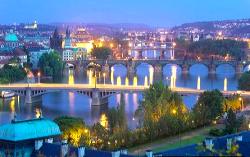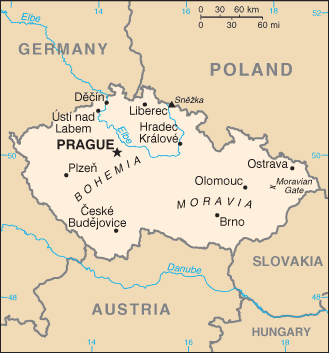Czech Republic is a small landlocked country in Central Europe. The capital and largest city is Prague. Prague Castle is one of the biggest castles in the world and Charles Bridge is a famous historical bridge in Prague. Of the former communist countries in central and Eastern Europe, the Czech Republic has one of the most developed and industrialized economies. The Czech economy is growing at a higher rate than the EU average. It is a desirable place for investments and business activities. Unmistakable Czech beer, cars and excellent glass products are popular the world over. The Czech Republic is a pluralist multi-party parliamentary representative democracy. The Czech Republic scores highly in financial freedom, monetary freedom, fairly high in fiscal freedom and labor freedom.

| Area: | 78,867 sq km |
|---|---|
| Population: | 10,201,707 |
| Religion: | Roman Catholic 26.8%, Protestant 2.1%, other 3.3%, unspecified 8.8%, unaffiliated 59% |
| Languages: | Czech 94.9%, Slovak 2%, other 2.3%, unidentified 0.8% |
| Government type: | parliamentary democracy |
| Capital: | Prague |
| Currency: | Koruna |
Background
Following the First World War, the closely related Czechs and Slovaks of the former Austro-Hungarian Empire merged to form Czechoslovakia. During the interwar years, the new country’s leaders were frequently preoccupied with meeting the demands of other ethnic minorities within the republic, most notably the Sudeten Germans and the Ruthenians (Ukrainians). After World War II, a truncated Czechoslovakia fell within the Soviet sphere of influence. In 1968, an invasion by Warsaw Pact troops ended the efforts of the country’s leaders to liberalize Communist party rule and create “socialism with a human face.” Anti-Soviet demonstrations the following year ushered in a period of harsh repression. With the collapse of Soviet authority in 1989, Czechoslovakia regained its freedom through a peaceful “Velvet Revolution”. On 1 January 1993, the country underwent a “velvet divorce” into its two national components, the Czech Republic and Slovakia. The Czech Republic joined NATO in 1999 and the European Union in 2004.
Economy
The Czech Republic is one of the most stable and prosperous of the post-Communist states of Central and Eastern Europe. Growth in 2000-05 was supported by exports to the EU, primarily to Germany, and a strong recovery of foreign and domestic investment. Domestic demand is playing an ever more important role in underpinning growth as interest rates drop and the availability of credit cards and mortgages increases. The current account deficit has declined to around 3% of GDP as demand for Czech products in the European Union has increased. Inflation is under control. Recent accession to the EU gives further impetus and direction to structural reform. Intensified restructuring among large enterprises, improvements in the financial sector, and effective use of available EU funds should strengthen output growth.
Geography
The Czech landscape is quite varied; Bohemia to the west consists of a basin, drained by the river Labe and Vltava rivers, surrounded by mostly low mountains such as the Sudetes with its part Krkonoše, where one also finds the highest point in the country, the Sněžka at 1,602 meters. Moravia, the eastern part, is also quite hilly and is drained predominantly by the Morava river, but also contains the source of the Odra river. Water from the landlocked Czech Republic flows to three different seas: the North Sea, Baltic Sea and Black Sea. The Czech Republic also possesses a 30,000 m² exclave in the middle of the Hamburg docks which was awarded to Czechoslovakia by Article 363 of the Treaty of Versailles to allow the landlocked country a place where goods transported downriver could be transferred to seagoing ships; this territory reverts to Germany in 2018.

Culture
The National Theater in Prague belongs to the most important Czech cultural institutions with a rich artistic tradition which was created and maintained by the most distinguished personalities in Czech society. This tradition helped to preserve and develop the most important features of the nation – the Czech language and a sense for a Czech musical and dramatic way of thinking. Czech literature is the literature of the historical regions of Bohemia, Moravia, and the Czech-speaking part of Silesia. This most often means literature written by Czechs, in the Czech language, although Old Church Slavonic, Latin, and German were also used, mostly in the early periods. Modern authors from the Czech territory who wrote in other languages (e.g. German) are generally considered separately, and their writing usually existed in parallel with Czech-language literature and did not interact with it. Thus Franz Kafka, for example, who wrote in German (though he also knew Czech rather well), falls within Austrian literature, though he lived his entire life in Bohemia. Music in the Czech Republic has roots both in high culture opera and symphony and in the folk musics of Bohemia and Moravia. Cross-pollination and diversity are important aspects of the music: composers were often influenced by folk music, Jazz and Bluegrass music have become popular, pop music often consists of English language hits sung in Czech.
Education
The Czech education system is based on a long tradition beginning in 1774, when compulsory school attendance was instituted. Currently, there are all types of education – starting with preschool, through elementary, secondary, university and postgraduate and ongoing education.
Children usually gain elementary education at elementary schools. Compulsory school attendance takes nine years, usually from the age of 6 till the age of 15. However, children may receive this level of education at various types of schools that can also utilize different types of educational programs.
Pupils who have fulfilled the nine-year compulsory school attendance can apply for study at a secondary school.
Tertiary education is included in studies following completed secondary education with a leaving exam. Tertiary education includes advanced vocational and university education. The teaching system is almost identical with the system at the college, vocational colleges; however, certain rules of secondary education apply (holidays, fixed timetables, etc.).
Higher vocational education deepens general and professional knowledge and takes three years in the daily form, practice included, and three and a half years for medicine and certain other fields of study. Study is finished by a certificate, a specific exam on selected subjects, a practical exam and the defense of a graduate examination paper – of course, everything in relation to the subject studied. Together with the certificate, students are awarded the title of certified specialist (the abbreviation DiS. is added after a name).
At vocational colleges, students must pay tuition fees. These tuition fees range from several thousand Czech crowns per year to several tens of thousands.
University education is available to all applicants with completed secondary education (i.e. leaving exam) who successfully pass the entrance exam. The system of entrance exams is specified individually by each college, and serves for testing the knowledge and skills of applicants.
Most universities have the following accredited degree programs:
- Bachelor’s: Usually a three-year course of study in which students get an elementary survey of highly specialized areas. Students can either leave their studies after these three years, or they can complete it by means of a leaving exam including the defense of a bachelor’s thesis, or may continue into the master’s program, where they can achieve a narrower specialization.
- Master’s: Operates either as five-year (or, more precisely, six-year), or as two-year programs following bachelor’s studies. During the course, students gain both a basic survey of highly specialized subjects and a certain grade of specialization. The program culminates with students taking required state leaving exams and defending their diploma thesis.
- Engineering: Relates to technical and economic fields.
After students pass these types of university study, some continue in their specialization through doctoral programs. Passing this program is often conditioned with certain publication work and sometimes also by training.
At college, students can study either in attendance form (formerly daily study), distance form (formerly extramural studies), or combine both forms of study (combined study).
Besides standard types of study, colleges offer also other forms of education: retraining study, university for seniors, studies oriented toward pedagogical qualification, etc.
Because of growing interest, some schools in the Czech Republic provide also study programs leading to the degree of Master’s of Business Administration. This study is oriented around problems addressed by teams and solving real-life case studies. Students exchange experiences from their own practice, thus enhancing their managerial knowledge and skills.
Because in the past the quality of study was not guaranteed by the Ministry of Education, Youth and Sports of the Czech Republic (as it is for universities), the Czech MBA Schools Association was established in 1998, and, upon the success of the demanding accreditation process, awards a certain “quality status” to the program.
Foreign Students:
Foreign students who meet some basic requirements can attend Czech universities and also secondary and primary schools. Except for specialized schools, most institutions require a knowledge of the Czech language.
Foreign students study at tertiary schools under the same conditions as Czech citizens, provided that they are able to study in Czech. Therefore, since Czech students are not required to pay for their studies, the same conditions apply to foreign students.
Foreign students wishing to study at a Czech tertiary school in another language than the Czech language must pay tuition. At private tertiary schools, all students are required to pay tuition; the same conditions apply to Czech citizens and foreigners alike.
If students are unable to pay for their studies and living expenses, they can try to apply to some of the scholarship programs .
Admissions for study at a tertiary school is subject to the completion of a full secondary or full secondary vocational education. Artistic study programs may be attended by applicants having completed the higher vocational education provided at conservatories and, as an exception, applicants not having completed the full secondary, secondary vocational or higher vocational education.
Admissions proceedings will take place on dates determined by the school, and the student will be examined in subjects related to the selected field of study. Once notified of the decision approving admission, the applicant becomes entitled for registration with the school. Within the term stipulated by the tertiary school or faculty, the applicant registers for study. Upon registration, the applicant becomes a student and acquires the right to an ISIC card and other advantages.
Myanmar Connections
If you have additional information or suggestions for this section, please contact myanmarstudyabroad@gmail.com

